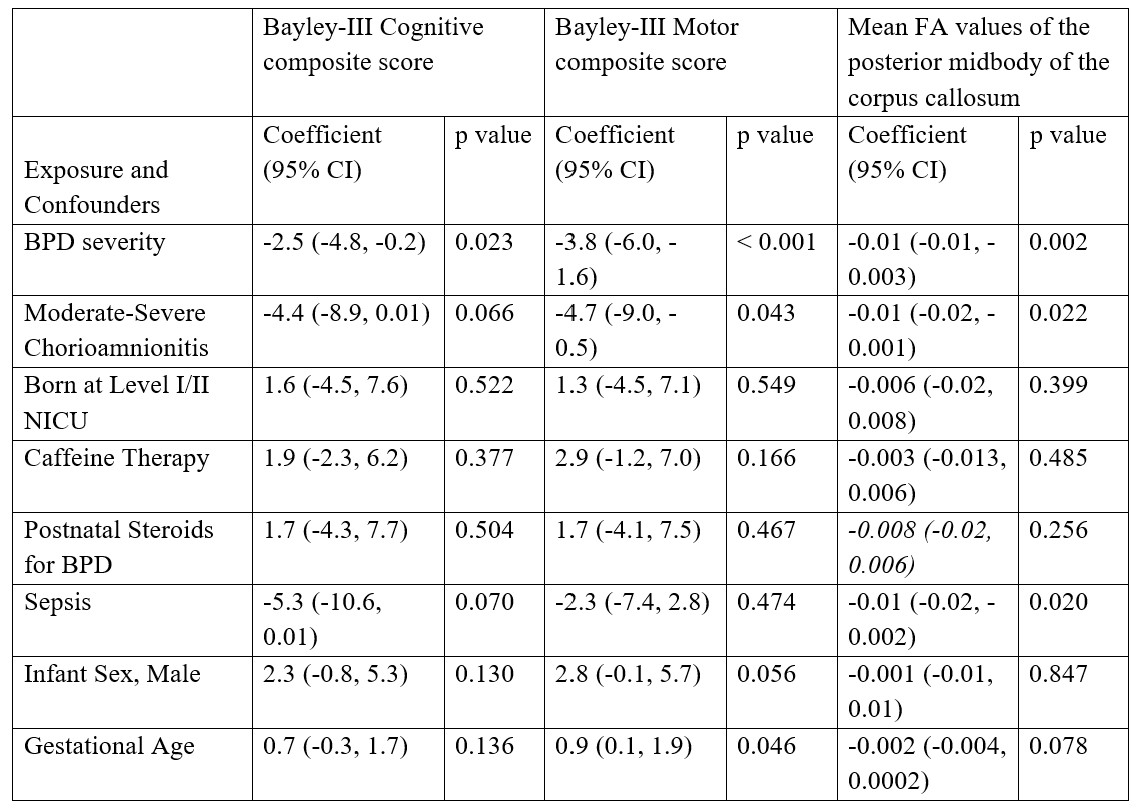Neonatal Neurology 2
Session: Neonatal Neurology 2
347 - Bronchopulmonary Dysplasia Associated Neurodevelopmental Impairments in Preterm Infants are Partially Mediated Via Early Corpus Callosum Microstructural Development
Friday, April 25, 2025
5:30pm - 7:45pm HST
Publication Number: 347.4181
Kylan A. Nelson, Cincinnati Children's Hospital Medical Center, Dayton, KY, United States; Katsuaki Kojima, Cincinnati Children's Hospital, Montgomery, OH, United States; Anoosha Sri, University of Cincinnati College of Medicine, Cincinnati, OH, United States; Julia Kline, National Institutes of Health, Bethesda, MD, United States; Mekibib Altaye, Cincinnati Children's Hospital Medical Center, CINCINNATI, OH, United States; beth Kline-Fath, Cincinnati Children's Hospital Medical Center, Cincinnati, OH, United States; Nehal A. Parikh, Cincinnati Children's Hospital Medical Center, Cincinnati, OH, United States

Kylan A. Nelson, MD (she/her/hers)
Pediatrics Resident
Cincinnati Children's Hospital Medical Center
Dayton, Kentucky, United States
Presenting Author(s)
Background: Preterm infants with bronchopulmonary dysplasia (BPD) experience worse neurodevelopmental outcomes. It is unclear whether infants with BPD exhibit distinct white matter microstructure abnormalities in the corpus callosum (CC) and if these differences influence developmental outcomes.
Objective: To investigate differences in CC and subsegment microstructure, as well as Bayley-III scores, among preterm infants with varying BPD severity. We hypothesized that higher BPD severity would be associated with lower Bayley scores and this relationship would be indirectly mediated via decreased fractional anisotropy (FA) in CC microstructure.
Design/Methods: This prospective cohort study includes 395 infants born at or below 32 weeks' gestation from five NICUs in a major metropolitan area. Diffusion tensor imaging (DTI) scans were acquired at 39-44 weeks postmenstrual age (PMA) on a single 3T scanner. We used TractSeg software to segment and calculate FA values of the CC and its seven subsegments. BPD severity was graded based on the respiratory support at 36 weeks PMA per Jensen et al. (2019). At two years corrected age, participants underwent Bayley-III developmental assessments. Confounders were selected based on literature review. Multivariable linear regression models were used to examine associations between BPD severity and mean FA of each CC subsegment, adjusting for confounders, and to assess the relationship between BPD severity and Bayley scores. Mediation analysis was performed to determine the extent to which CC microstructural development mediated the effects of BPD on developmental scores.
Results: Of the 395 infants, 392 were eligible for 2-year follow-up and 338 (86%) had complete data (Table 1). After adjusting for confounders, infants with higher BPD grades had significantly lower Cognitive scores (p = 0.023), Motor scores (p = 0.008), and mean FA values for the CC posterior midbody (p = 0.003) (Table 2). Mediation analysis revealed that CC posterior midbody FA values indirectly mediated the adverse effects of BPD on both Bayley Cognitive and Motor scores (p < 0.001; Figure 1). Specifically, FA value of the CC posterior midbody mediated 17% of the total adverse effect of BPD on cognitive development.
Conclusion(s): In this cohort of very preterm infants, higher BPD severity was significantly associated with worse scores on the 2-year Bayley-III assessment, and this effect was partially mediated by worse microstructural development of the posterior midbody of the CC through term-corrected age.
Table 1
.jpg) Demographics and clinical characteristics.
Demographics and clinical characteristics.Table 2
 Results from multivariable linear regression models exploring the link between BPD severity with neurodevelopmental and neuroimaging outcomes.
Results from multivariable linear regression models exploring the link between BPD severity with neurodevelopmental and neuroimaging outcomes.Figure 1
.jpg) Legend: Mediation analyses. Our two models demonstrate significant associations between BPD grade and Bayley-III Motor and Cognitive composite scores at 2-years corrected age (the total effect) and a significant indirect effect of CC posterior midbody microstructural development assessed from DTI at term-corrected age. The sum of the indirect effect (through the effect of BPD grade on DTI measures) and direct effect is the total effect.
Legend: Mediation analyses. Our two models demonstrate significant associations between BPD grade and Bayley-III Motor and Cognitive composite scores at 2-years corrected age (the total effect) and a significant indirect effect of CC posterior midbody microstructural development assessed from DTI at term-corrected age. The sum of the indirect effect (through the effect of BPD grade on DTI measures) and direct effect is the total effect. 
